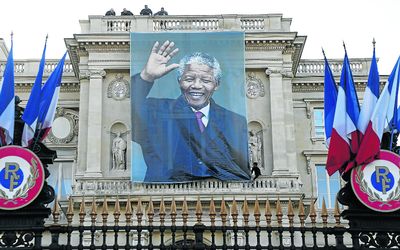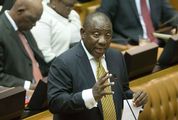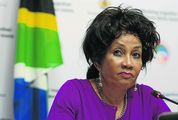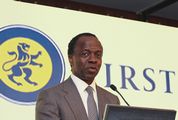THE death of former president Nelson Mandela leaves a waning number of global figures representing freedom and resilience against oppression — and a changing world that makes it harder for anyone to approach his iconic power.
There are a few whose trials have made them symbols of freedom, including the former political prisoner Aung San Suu Kyi of Myanmar, the Dalai Lama and, more recently, Malala Yousafzai, the Pakistani schoolgirl turned women’s rights activist.
But Mr Mandela, who emerged from 27 years in prison to embrace his white oppressors and lead a new South Africa, may be one of the last of a breed for all sorts of reasons — including the circumstances of his heroism, his extraordinary success and the onset of an age when heroes’ foibles are often exposed.
"He lived and worked in a context and historical period where his extraordinary individual qualities could help make change in his country and ripple throughout the world," said Daniel Calengaret, executive vice-president of the Freedom House, a watchdog group working to expand freedom around the world.
"It’s hard to think of someone who was both an iconic dissident figure and was actually central to building a new system."
Mr Mandela is often mentioned in the same breath as Mahatma Gandhi and Martin Luther King, who also changed nations through nonviolence. Yet Gandhi and King were killed before their dreams were realised.
Myanmar prodemocracy leader, Ms Suu Kyi, was jailed by the military regime for 15 years before she was released and won a parliamentary seat. Yet she battles in a political arena lacking the stark racism of apartheid. "She stands for the end of a dictatorship, not the end of a racial system," said Dores Cruz, a University of Denver anthropology professor.
Prof Cruz said the dismantling of communism by the Soviet leader, Mikhail Gorbachev, is comparable to Mr Mandela ending apartheid. But Mr Gorbachev did not suffer personal persecution to do it.
She said that Mr Mandela’s image was carefully constructed for political purposes in pre-internet South Africa, then burnished over the years by international media, musicians and Hollywood.
"The impact that has had on the historical imagination, you probably won’t find that in anybody," Prof Cruz said. "No one has the same iconic image or same historical status."
The Dalai Lama, a Buddhist figure seeking the nonviolent restoration of Tibet’s independence from China, has lived in exile for more than 60 years.
There is an ethnic or racial aspect to the Tibetan struggle as China seeks to wipe out its traditional culture and replace it with that of the Han Chinese.
"Like Mandela, the Dalai Lama represents the decades-long suffering of his people. And he articulates a peaceful possibility in response to violence and aggression," said William Edelglass, a Marlboro College philosophy professor.
"Like Mandela, he inspires us to the better angels of our nature," Prof Edelglass said.
"He reminds us of how we really want to be."
But at age 78, with China firmly in control, the Dalai Lama is unlikely to see a free Tibet. His Buddhist religion sets him apart from Mr Mandela, who enjoyed a type of secular sainthood that transcended religious divides. Ms Yousafzai, the Pakistani girl, achieved global prominence last year when the Taliban tried to kill her for advocating the equality and education of women. After Mr Mandela’s death, she called him "my leader".
"One of the things about Mandela that makes him unique, all those years in prison, he couldn’t be really doing bad things during that time. And he lived prior to universal access," Prof Edelglass said.
He sees the potential for another Mandela in the fight for democracy in China, "but we would know everything about that person, everything they had ever done wrong".
"I wouldn’t want to say there are no more (figures like Mandela) coming. I hope there are more coming," Prof Edelglass said. "But it’s a much more complicated world."
Roger Levine, who grew up in South Africa and teaches courses on it as a history professor at the Sewanee, the University of the South, in Tennessee, said Mr Mandela became such a potent symbol because he experienced all the tribulations of South Africa itself.
But the world no longer builds up politicians as the embodiment of their nations’ struggles, he said.
Mr Mandela was a product of a Cold War world: good versus evil, us versus them, black versus white. "Now it’s a whole lot harder … No one is going to suggest there aren’t instances around the world where we have conflict between good and evil.
"But there are fewer opportunities to say you’re on the right side, because it’s a little bit less obvious what the right side of something might be."
Sapa

GLOBAL ICON: A banner of Nelson Mandela covers the facade of the foreign affairs ministry at Quai d’Orsay in Paris. Picture: REUTERS
THE death of former president Nelson Mandela leaves a waning number of global figures representing freedom and resilience against oppression — and a changing world that makes it harder for anyone to approach his iconic power.
There are a few whose trials have made them symbols of freedom, including the former political prisoner Aung San Suu Kyi of Myanmar, the Dalai Lama and, more recently, Malala Yousafzai, the Pakistani schoolgirl turned women’s rights activist.
But Mr Mandela, who emerged from 27 years in prison to embrace his white oppressors and lead a new South Africa, may be one of the last of a breed for all sorts of reasons — including the circumstances of his heroism, his extraordinary success and the onset of an age when heroes’ foibles are often exposed.
"He lived and worked in a context and historical period where his extraordinary individual qualities could help make change in his country and ripple throughout the world," said Daniel Calengaret, executive vice-president of the Freedom House, a watchdog group working to expand freedom around the world.
"It’s hard to think of someone who was both an iconic dissident figure and was actually central to building a new system."
Mr Mandela is often mentioned in the same breath as Mahatma Gandhi and Martin Luther King, who also changed nations through nonviolence. Yet Gandhi and King were killed before their dreams were realised.
Myanmar prodemocracy leader, Ms Suu Kyi, was jailed by the military regime for 15 years before she was released and won a parliamentary seat. Yet she battles in a political arena lacking the stark racism of apartheid. "She stands for the end of a dictatorship, not the end of a racial system," said Dores Cruz, a University of Denver anthropology professor.
Prof Cruz said the dismantling of communism by the Soviet leader, Mikhail Gorbachev, is comparable to Mr Mandela ending apartheid. But Mr Gorbachev did not suffer personal persecution to do it.
She said that Mr Mandela’s image was carefully constructed for political purposes in pre-internet South Africa, then burnished over the years by international media, musicians and Hollywood.
"The impact that has had on the historical imagination, you probably won’t find that in anybody," Prof Cruz said. "No one has the same iconic image or same historical status."
The Dalai Lama, a Buddhist figure seeking the nonviolent restoration of Tibet’s independence from China, has lived in exile for more than 60 years.
There is an ethnic or racial aspect to the Tibetan struggle as China seeks to wipe out its traditional culture and replace it with that of the Han Chinese.
"Like Mandela, the Dalai Lama represents the decades-long suffering of his people. And he articulates a peaceful possibility in response to violence and aggression," said William Edelglass, a Marlboro College philosophy professor.
"Like Mandela, he inspires us to the better angels of our nature," Prof Edelglass said.
"He reminds us of how we really want to be."
But at age 78, with China firmly in control, the Dalai Lama is unlikely to see a free Tibet. His Buddhist religion sets him apart from Mr Mandela, who enjoyed a type of secular sainthood that transcended religious divides. Ms Yousafzai, the Pakistani girl, achieved global prominence last year when the Taliban tried to kill her for advocating the equality and education of women. After Mr Mandela’s death, she called him "my leader".
"One of the things about Mandela that makes him unique, all those years in prison, he couldn’t be really doing bad things during that time. And he lived prior to universal access," Prof Edelglass said.
He sees the potential for another Mandela in the fight for democracy in China, "but we would know everything about that person, everything they had ever done wrong".
"I wouldn’t want to say there are no more (figures like Mandela) coming. I hope there are more coming," Prof Edelglass said. "But it’s a much more complicated world."
Roger Levine, who grew up in South Africa and teaches courses on it as a history professor at the Sewanee, the University of the South, in Tennessee, said Mr Mandela became such a potent symbol because he experienced all the tribulations of South Africa itself.
But the world no longer builds up politicians as the embodiment of their nations’ struggles, he said.
Mr Mandela was a product of a Cold War world: good versus evil, us versus them, black versus white. "Now it’s a whole lot harder … No one is going to suggest there aren’t instances around the world where we have conflict between good and evil.
"But there are fewer opportunities to say you’re on the right side, because it’s a little bit less obvious what the right side of something might be."
Sapa




















Register/Login
Close XMy News
You can only set up or view personalised news headlines when you are logged in as a registered user. Thereafter you can choose the sectors of industry in which you are interested, and the latest articles from those sectors will display in this area of your console.
Login or Register.Top Stories
My Watchlist
You can only set up or view your share watchlist when you are logged in as a registered user. Thereafter you can select a list of companies and enter your share details to monitor their performance.
Login or Register.My Clippings
You can only clip articles when you are logged in as a registered user. Thereafter you can click on the "Read later" icon at the top of an article to save it to this area of your console, where you can return to read it at any time.
Login or Register.Change: -1.21%
Change: -1.31%
Change: -1.11%
Change: -1.12%
Change: -2.16%
Data supplied by Profile Data
Change: 0.00%
Change: 0.00%
Change: -1.21%
Change: 0.00%
Change: 0.00%
Data supplied by Profile Data
Change: -0.56%
Change: -0.01%
Change: 0.11%
Change: -0.53%
Change: -0.10%
Data supplied by Profile Data
Change: 0.00%
Change: 0.00%
Change: 0.00%
Change: 0.00%
Change: 0.00%
Data supplied by Profile Data